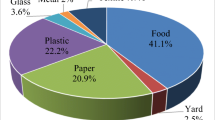Abstract
In this paper, a new methodology is developed for early detecting leakage from landfills to groundwater systems. The optimal number and locations of monitoring wells are determined with respect to maximizing the probability of detecting a pollution source and minimizing the total cost of monitoring system. The concentration of a water quality indicator is simulated by analytically solving the mass transport equations in porous media. In the developed methodology, the uncertainties associated with the leakage characteristics as well as parameters related to pollution mass transport equations are addressed using the fuzzy set theory. Also, a fuzzy transformation technique is utilized, which decomposes the fuzzy membership functions into a number of intervals called \( \alpha \)-cuts. Corresponding to each leakage scenario, fuzzy membership function of the concentration of the water quality indicator at each monitoring well is obtained using the fuzzy transformation technique. The resulted fuzzy numbers are compared with a fuzzy threshold for detecting pollution using a fuzzy ranking technique. Finally, the optimum number of monitoring wells with their best locations can be determined using a trade-off curve between the probability of pollution detection and the number of monitoring wells. For real-time operation of the monitoring system, a probabilistic artificial neural network is trained and verified which provides the probability of occurring leakage at each section of the landfill based on the concentration of the water quality indicator at the monitoring wells. The applicability and effectiveness of the proposed methodology in detecting pollution leakage from landfills are examined by applying it to a case study in Iran.







Similar content being viewed by others
References
Bashi-Azghadi SN, Kerachian R (2010) Locating monitoring wells in groundwater systems using embedded optimization and simulation models. Sci Total Environ 408(10):2189–2198
Bashi-Azghadi SN, Kerachian R, Bazargan-Lari MR, Solouki K (2010) Characterizing an unknown pollution source in groundwater resources systems using PSVM and PNN. Expert Syst Appl 37(10):7154–7161
Bashi-Azghadi SN, Kerachian R, Bazargan-Lari MR, Nikoo MR (2016) Pollution source identification in groundwater systems: application of regret theory and bayesian networks. Iran. J. Sci. Technol. Trans. Civ. Eng. doi:10.1007/s40996-016-0022-3
Chen SM, Wang CH (2009) ‘Fuzzy risk analysis based on ranking fuzzy numbers using α-cuts, belief features and signal/noise ratios’. Expert Syst Appl 36:5576–5581
Dhar A, Datta B (2010) Logic-based design of groundwater monitoring network for redundancy reduction. J Water Resour Plan Manag 136:88
Dhar A, Patil RS (2012) Multiobjective design of groundwater monitoring network under epistemic uncertainty. Water Resour Manag 26:1809–1825
Hanss M (2002) The transformation method for the simulation and analysis of systems with uncertain parameters. Fuzzy Sets Syst 130:277–289
Hudak PF (2001) ‘Effective contaminant detection networks in uncertain, waste management’. Waste Manag 21:309–312
Karamouz M, Szidarovszky F, Zahraie B (2003) Water resources system analysis-with emphasis on conflict resolution. CRC Publishing, Boca Raton 33431
Loaiciga HA, Charbeneau RJ, Everett LG, Fogg GE, Hobbs BF, Rouhani S (1992) Review of groundwater quality monitoring network design. J Hydraul Eng ASCE 118(1):11–37
Masoumi F, Kerachian R (2010) Optimal redesign of groundwater quality monitoring networks: a case study. Environ Monit Assess 161(1):247–257
Nasrabadi T, Abbasi Maedeh P (2014) Groundwater quality assessment in southern parts of Tehran plain, Iran’. Environ Earth Sci 71(5):2077–2086
Neville CJ (1994) Compilation of analytical solutions for solute transport in uniform flow. S.S. Papadopulos and Associates, Bethesda
Nikoo MR, Mahjouri N (2013) Water quality zoning using probabilistic support vector machines and self-organizing maps. Water Resour Manag 27(7):2577–2594
Nikoo MR, Kerachian R, Karimi A, Azadnia AA (2013) Optimal water and waste-load allocations in rivers using a fuzzy transformation technique: a case study. Environ Monit Assess 185(3):2483–2502
Nunes LM, Cunha MDC, Ribeiro L (2013) Coverage methods for early groundwater contamination detection. Bull Environ Contam Toxicol 90:531–536
Qin XS (2012) Assessing environmental risks through fuzzy parameterized probabilistic analysis. Stoch Environ Res Risk Assess 26:43–58
ReVelle C, Mc Garity AE (1997) Design and operation of civil and environmental engineering systems. Wiley, New York, p 752
Yenigül NB, Hensbergen AT, Elfeki AMM, Dekking FM (2011) Detection of contaminant plumes released from landfills: numerical versus analytical solutions. Environ Earth Sci 64(8):2127–2140
Yenigül NB, Elfeki AMM, van den Akker C, Dekking FM (2013) Optimizing groundwater monitoring systems for landfills with random leaks under heterogeneous subsurface conditions. Hydrogeol J. doi:10.1007/s10040-013-1013-0
Author information
Authors and Affiliations
Corresponding author
Rights and permissions
About this article
Cite this article
Mahjouri, N., Shamsoddinpour, M. Developing a methodology for early leakage detection in landfills: application of the fuzzy transformation technique and probabilistic artificial neural networks. Environ Earth Sci 75, 1000 (2016). https://doi.org/10.1007/s12665-016-5757-4
Received:
Accepted:
Published:
DOI: https://doi.org/10.1007/s12665-016-5757-4




